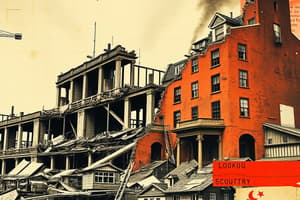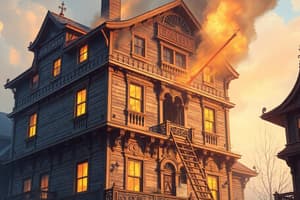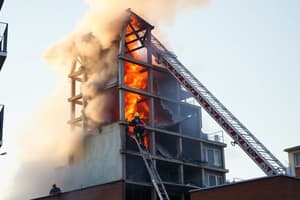Podcast
Questions and Answers
Which type of building has the least resistant to collapse during a fire?
Which type of building has the least resistant to collapse during a fire?
- Concrete buildings
- Heavy timber buildings
- Class 2 non combustible (correct)
- Class 5 buildings
What material is typically more resistant to collapse than wood-frame buildings?
What material is typically more resistant to collapse than wood-frame buildings?
- Brick
- Wood composites
- Heavy timber (correct)
- Steel
In standard construction methods, what is more likely to happen before a typical wooden home collapses?
In standard construction methods, what is more likely to happen before a typical wooden home collapses?
- It expands due to heat
- It experiences a partial collapse
- It disintegrates
- It burns through (correct)
Which class of building has the greatest resistance to collapse?
Which class of building has the greatest resistance to collapse?
What type of buildings have the highest resistance to collapse?
What type of buildings have the highest resistance to collapse?
What is the most dangerous condition associated with Class 1 buildings?
What is the most dangerous condition associated with Class 1 buildings?
What might happen to I-beams in a Class 1 fireproof building during a fire?
What might happen to I-beams in a Class 1 fireproof building during a fire?
Which statement is true concerning the performance of heavyweight buildings during high-rise fires?
Which statement is true concerning the performance of heavyweight buildings during high-rise fires?
What is the primary reason some high-rise office fires do not lead to total collapse, despite combustibles being consumed?
What is the primary reason some high-rise office fires do not lead to total collapse, despite combustibles being consumed?
What factor is contributing to an increased risk of structural collapse in modern construction?
What factor is contributing to an increased risk of structural collapse in modern construction?
Which of the following incidents resulted in the highest number of firefighter fatalities?
Which of the following incidents resulted in the highest number of firefighter fatalities?
What is the primary reason structural collapse is viewed as a serious threat on the fireground?
What is the primary reason structural collapse is viewed as a serious threat on the fireground?
Which collapse listed is associated with the least firefighter casualties?
Which collapse listed is associated with the least firefighter casualties?
Which material is primarily used in the construction of the third most collapse-resistant building?
Which material is primarily used in the construction of the third most collapse-resistant building?
What happens to the floor sheathing in the third most collapse-resistant building during a fire?
What happens to the floor sheathing in the third most collapse-resistant building during a fire?
What risk is associated with unusually high floor loads in these buildings?
What risk is associated with unusually high floor loads in these buildings?
What should be done if unusually high or concentrated loads are discovered?
What should be done if unusually high or concentrated loads are discovered?
What defines the special category for collapse resistance regarding lightweight and truss-construction methods?
What defines the special category for collapse resistance regarding lightweight and truss-construction methods?
What can lead to the collapse of subsequent floors in a building during a fire?
What can lead to the collapse of subsequent floors in a building during a fire?
What is the recommended distance for removing apparatus from the collapse zone during advanced fires?
What is the recommended distance for removing apparatus from the collapse zone during advanced fires?
Which condition can destabilize buildings, making them vulnerable to collapse during a fire?
Which condition can destabilize buildings, making them vulnerable to collapse during a fire?
What can be the outcome of a seemingly minor fire in a structurally compromised building?
What can be the outcome of a seemingly minor fire in a structurally compromised building?
What is the primary reason Class 2 construction is less resistant to collapse when exposed to fire?
What is the primary reason Class 2 construction is less resistant to collapse when exposed to fire?
Which characteristic of steel under heating poses a risk of collapse?
Which characteristic of steel under heating poses a risk of collapse?
What structural effect occurs when steel cools after being heated and distorted?
What structural effect occurs when steel cools after being heated and distorted?
Collapses in framed structures tend to be localized. What is typically the scope of such a collapse?
Collapses in framed structures tend to be localized. What is typically the scope of such a collapse?
At what temperature does steel begin to lose approximately half of its strength?
At what temperature does steel begin to lose approximately half of its strength?
What is a primary characteristic of unframed buildings?
What is a primary characteristic of unframed buildings?
What typically happens when a vertical member fails in a building structure?
What typically happens when a vertical member fails in a building structure?
Which of the following materials is typically associated with unframed buildings?
Which of the following materials is typically associated with unframed buildings?
In what way do framed and unframed structures respond to collapses?
In what way do framed and unframed structures respond to collapses?
Which structural system is more likely to cause severe damage throughout when a failure occurs?
Which structural system is more likely to cause severe damage throughout when a failure occurs?
Which structural element is considered the least critical in maintaining a building's stability?
Which structural element is considered the least critical in maintaining a building's stability?
What is a more serious consequence of failure in a building's structure?
What is a more serious consequence of failure in a building's structure?
In the hierarchy of structural components, which element is ranked immediately below bearing walls?
In the hierarchy of structural components, which element is ranked immediately below bearing walls?
Which of the following represents a component that supports other structural elements but is not as critical as a column?
Which of the following represents a component that supports other structural elements but is not as critical as a column?
How does the failure of a horizontal member like a beam compare to that of a column?
How does the failure of a horizontal member like a beam compare to that of a column?
Flashcards
Structural Collapse
Structural Collapse
A rapid and potentially fatal building failure, relatively uncommon in firefighting.
Firefighter Casualties
Firefighter Casualties
Fatalities among firefighters caused by structural collapses during fires.
Lightweight Construction
Lightweight Construction
Building materials that are less dense and stronger than traditional building materials.
Class 1 Building
Class 1 Building
Signup and view all the flashcards
Localized Damage
Localized Damage
Signup and view all the flashcards
World Trade Center Collapse
World Trade Center Collapse
Signup and view all the flashcards
Bearing Walls
Bearing Walls
Signup and view all the flashcards
Columns
Columns
Signup and view all the flashcards
Girders
Girders
Signup and view all the flashcards
Class 3 Construction
Class 3 Construction
Signup and view all the flashcards
Class 5 Construction
Class 5 Construction
Signup and view all the flashcards
Steel Expansion
Steel Expansion
Signup and view all the flashcards
Collapse Zone
Collapse Zone
Signup and view all the flashcards
Structural Failure Hierarchy
Structural Failure Hierarchy
Signup and view all the flashcards
Class 2 Construction
Class 2 Construction
Signup and view all the flashcards
Metal/Noncombustible
Metal/Noncombustible
Signup and view all the flashcards
Study Notes
Structural Collapse
- Structural collapse occurs rapidly and can be fatal, though such incidents are relatively rare among firefighters.
- Notable collapses with significant firefighter casualties include:
- Chicago Stockyards warehouse (1910) - 23 fatalities
- NYC 23rd Street building (1966) - 12 fatalities
- Vendome Hotel, Boston (1972) - 9 fatalities
- Waldbaum's Supermarket, Brooklyn (1978) - 6 fatalities
- Ford dealership, Hackensack, NJ (1988) - 5 fatalities
- Chevrolet dealership, Wichita, KS (1968) - 4 fatalities
- Two-story building, Brackenridge, PA (1991) - 4 fatalities
- World Trade Center on September 11, 2001 - 343 fatalities
- Increased use of lightweight materials in construction raises risk for firefighters during fires.
- Understanding collapse causes and preparation for them is vital for firefighter safety.
Building Collapse
- Class 1 fireproof buildings have the highest resistance to collapse, designed with reinforced concrete or steel I-beams and rated for up to 4 hours of fire resistance.
- These buildings typically experience localized damage instead of total collapses, aiding in evacuation and fire control.
- The collapses of the World Trade Center buildings illustrate the dangers of modern lightweight construction materials.
Windsor Fire
- The Windsor Building in Madrid suffered significant damage in 2005, with most of its steel frame collapsing while the concrete core remained standing.
- The outer floor sections used medium-weight steel with partially load-bearing exterior walls.
- The most hazardous scenario in Class 1 buildings arises from poured in place concrete structures.
Collapses and Their Effects
- Lower floor collapses can lead to subsequent failures in higher floors, especially during advanced fires.
- During fires, fire apparatus should be removed from the collapse zone, which extends half the height of the building from its wall.
- Old industrial buildings prone to multiple fires may become unstable and collapse from seemingly minor flames.
Resistance to Collapse
- Class 3 ordinary construction (brick and wood joist) has moderate resistance but may burn through before experiencing structural failure.
- Class 5 wood-frame buildings represent the lowest resistance to collapse.
- Metal or non-combustible materials generally provide better collapse resistance than wood frame or heavy timber.
Structural Components and Failure
- Framed structures with protected steel or concrete systems resist total collapse, mainly collapsing in localized areas.
- Class 2 constructions (metal/noncombustible) are susceptible to collapse due to large quantities of unprotected steel.
- Steel expands when heated and can lose significant strength under high temperatures, leading to potential collapses as steel cools back into distorted shapes.
Prioritizing Structural Failure
- Structural elements’ failure hierarchy indicates potential impacts on overall stability:
- Bearing walls are most crucial for support.
- Columns bear significant weight and are critical to stability.
- Girders support beams, followed by beams and joists, and finally the floor or roof decking.
- Failure of vertical members (columns/walls) can lead to more severe collapses than the failure of horizontal members (beams).
Studying That Suits You
Use AI to generate personalized quizzes and flashcards to suit your learning preferences.




